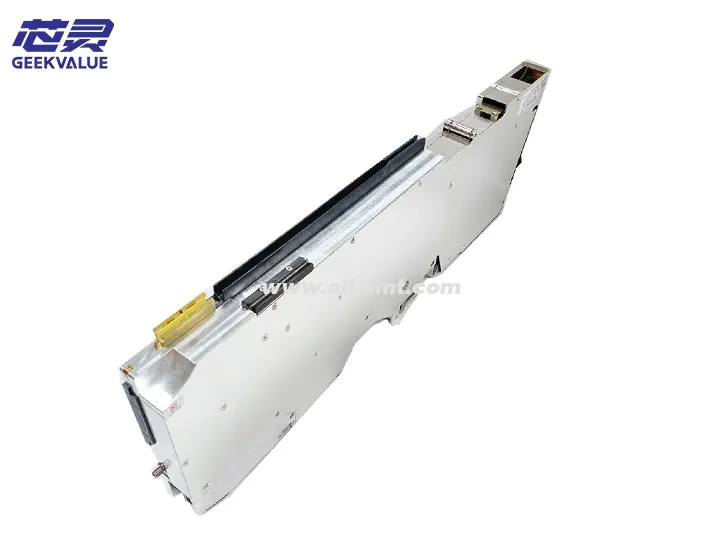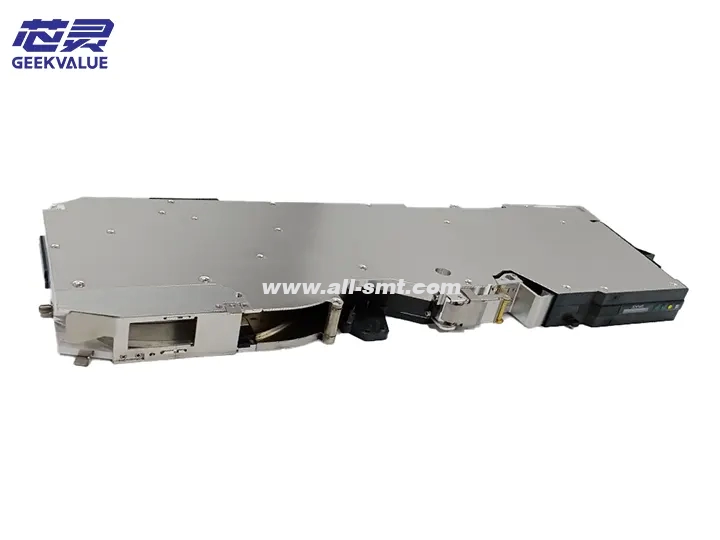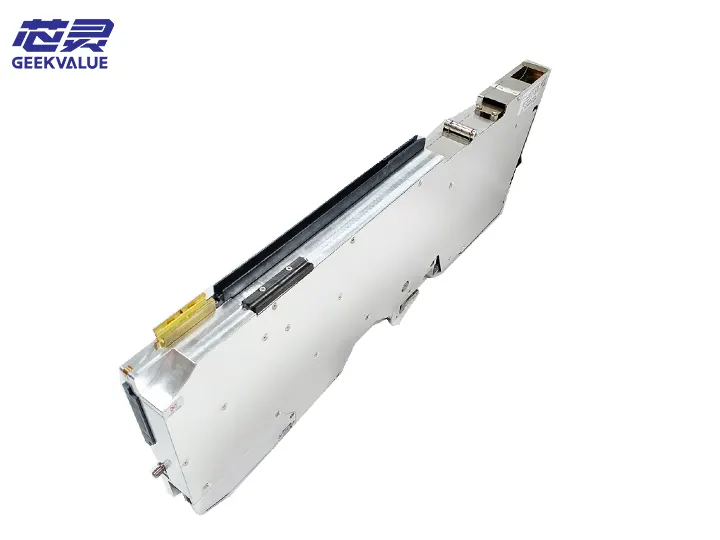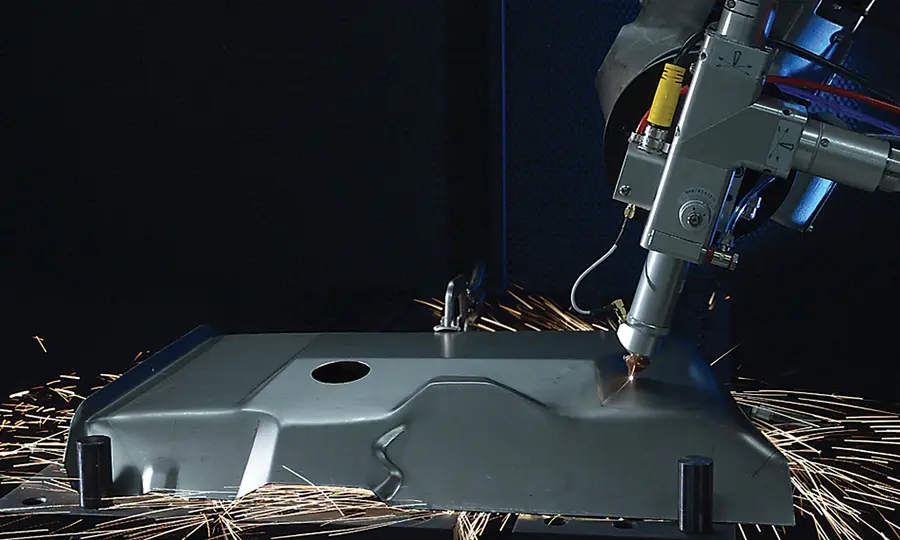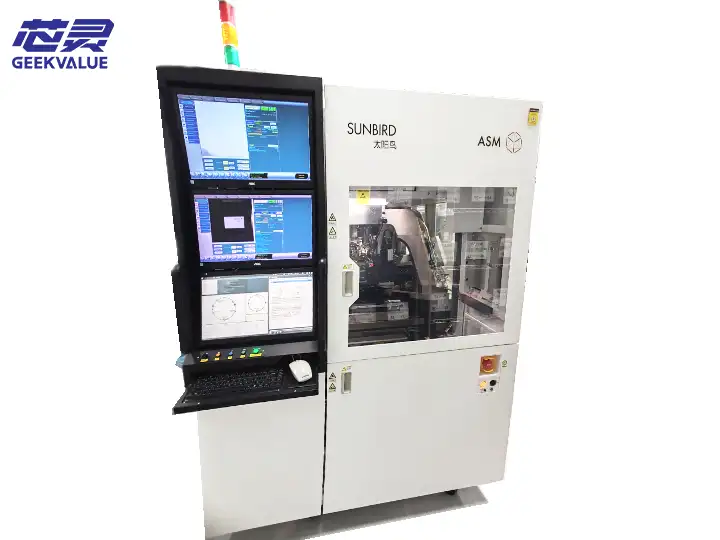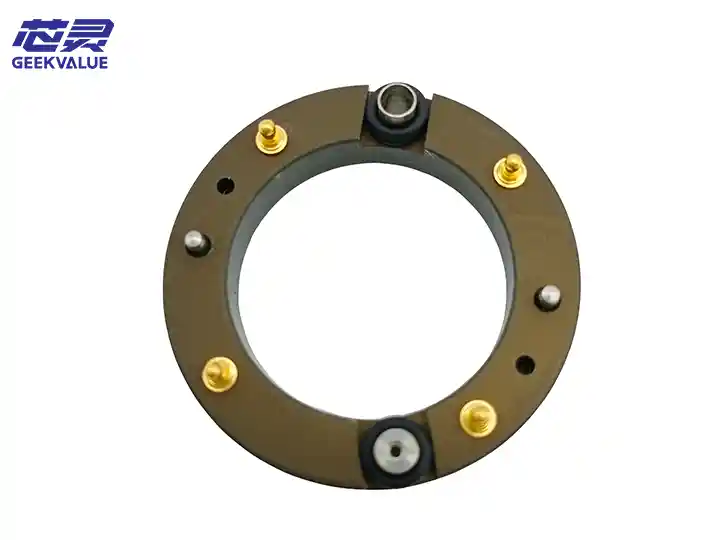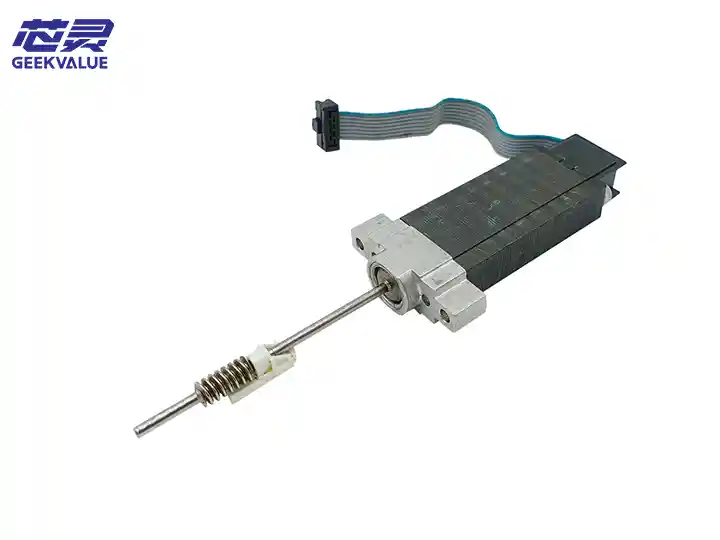1. Core features and technical parameters
Model positioning
Model: 00141273, belongs to the ASM X series feeder, designed for 24MM width tape, supports single-channel feeding, and does not have sensor functions such as tape margin detection and component position calibration.
Structural design:
Reel mechanism: Adapts to 7-inch or 13-inch diameter reels, driven by stepper motors to achieve high-precision tape feeding.
Tape clamping device: adopts wide-width pressure cover and partition design to ensure smooth conveying of 24MM tape and avoid offset or jamming.
Transmission system: The gear set cooperates with the synchronous wheel, and the step adjustment range covers 4MM, 8MM, 12MM, 16MM, and 20MM to meet the needs of different component spacing.
Tape rewinding wheel: integrated upper tape stripping function to keep the tape clean and reduce manual intervention.
Working principle: The patch head triggers the feeder stepper motor through a mechanical signal, drives the tape forward one step, and sends the component to the pick-up position. The whole process relies on manual monitoring of the material strip status.
Applicable scenarios
Component type: supports medium and large components with 24MM material strip packaging, such as QFP (quad flat package), SOP (small outline package), connectors, transformers, etc., which are widely used in automotive electronics, communication equipment, industrial control and other fields.
Machine adaptation: Compatible with ASM SIPLACE X series high-speed placement machine, especially suitable for production lines that require stable feeding and are cost-sensitive, and can reduce downtime through offline material preparation (Dockstation).
2. Core advantages
Mechanical stability and durability
Made of high-strength aluminum alloy material and precision gear set, it has strong wear resistance and can run continuously for tens of thousands of hours without failure.
The sensorless design reduces the loss of electronic components and has low maintenance costs, which is suitable for long-term high-load production environments.
Excellent cost performance
Compared with smart feeders with sensors, the price is reduced by about 30%-40%, and no additional calibration equipment (such as XFVS calibrator) is required, which is suitable for small and medium-sized enterprises with limited budgets.
The single-channel design reduces the feeder's occupation of the material slot and improves the utilization rate of the SMT material station, which is especially suitable for multi-variety small-batch production.
Convenient operation and maintenance
The material tape installation process is standardized, and the guide groove and synchronous wheel are used for quick positioning to reduce debugging time.
The modular structure supports quick disassembly, and the gears, pressure caps and other vulnerable parts can be replaced separately, and the maintenance cycle is short.
3. Common error messages and cause analysis
Mechanical failure
The material tape is blocked/stuck:
Cause: The pressure cap is deformed, the guide rail is fouled, the synchronous gear teeth are worn, or the edge of the material tape is damaged.
Performance: The material tape cannot move forward, and the SMT head frequently sucks or throws the material.
Feeding offset/inaccurate step distance:
Cause: The stepper motor gear gap is too large, the step is lost, or the transmission belt is loose.
Performance: The component pick-up position is offset, resulting in misalignment or collision of the patch.
Tape reeling failure:
Cause: The spring of the tape reeling wheel is fatigued, the ratchet mechanism is damaged, or the tension of the upper tape is insufficient.
Performance: The peeled upper tape is fouled, the material tape is entangled, or the gear is involved.
Electrical failure
Motor does not move/feeding stops:
Reason: driver board failure, motor connection line disconnection or poor power contact.
Performance: feeder does not respond, patch head waiting timeout alarm.
Abnormal heating:
Reason: motor overload, gear meshing too tight or poor heat dissipation.
Performance: feeder surface temperature rises abnormally, which may be accompanied by odor.
System abnormality
Increased throwing rate:
Reason: skewed tape installation, component thickness detection deviation or insufficient vacuum suction.
Performance: The patch head frequently throws materials, affecting production efficiency and material costs.
Equipment compatibility alarm:
Reason: feeder coding label wear, model identification error or incompatible patch machine firmware version.
Performance: The patch machine prompts "feeder type does not match" or "unauthorized device".
4. Maintenance methods
Daily maintenance (every shift/daily)
Cleaning:
Use a brush to remove residual materials, dust and oil stains on the guide rails, synchronous wheels and take-up wheels to prevent impurities from affecting the transmission accuracy of the tape.
Check the inside of the pressure cover and the separation plate to ensure that there are no component debris or tape residues.
Visual inspection:
Observe whether the tape runs smoothly and whether there are signs of deviation or jamming; check whether the transmission parts such as gears and chains are loose or worn.
Confirm that the take-up wheel rotates normally and there is no abnormal accumulation of the upper tape peeling.
Monthly maintenance
Lubrication and tightening:
Apply special lubricants (such as food-grade white oil) to the gear set, transmission shaft and sliding parts to reduce friction and wear.
Check and tighten the screws of the feeder housing, guide rails and motor to prevent loosening due to vibration.
Functional test:
Use a standard tape to simulate the feeding process and verify the stepper motor response, step accuracy (error must be ≤±0.02mm) and take-up wheel synchronization.
Test the elastic force of the pressure cover to ensure that it can firmly fix the material strip without damaging the components.
Quarterly in-depth maintenance
Component disassembly and inspection:
Remove the guide rail, synchronous wheel and take-up wheel assembly, thoroughly clean and check the wear, and replace the severely worn gears or bearings if necessary.
Check the resistance and insulation performance of the stepper motor winding to eliminate the hidden dangers of electrical failure.
System calibration:
Use special tools (such as the feeder calibrator) to calibrate the step accuracy and the parallelism of the material strip transmission to ensure that the placement position deviation is within the allowable range.
Verify the communication interface between the feeder and the placement machine, remove the oxidized contacts, and ensure stable signal transmission.
Annual comprehensive maintenance
Overall cleaning and performance testing:
Perform ultrasonic cleaning on the feeder to remove internal dirt and flux residues; reapply long-term lubricant.
Test the temperature rise and vibration parameters by running at full load for 8 hours continuously to evaluate durability.
Replacement of aging parts:
Replace all wearing parts (such as springs, belts, seals) and aging wiring harnesses to prevent sudden failures.
Update the driver board firmware (if any) to improve compatibility with the placement machine.
V. Maintenance ideas and troubleshooting
1. Pretreatment and fault location
Appearance inspection:
Check whether the feeder housing is deformed, whether the gear is missing teeth, and whether the cable interface is physically damaged.
Check whether there are foreign objects blocking the material belt path, and whether the meshing of the synchronous wheel and the material belt hole is normal.
Electrical diagnosis:
Use a multimeter to detect the resistance of the stepper motor coil to confirm whether it is short-circuited or open-circuited; check whether the power supply voltage of the driver board is stable.
Read the feeder status code (such as communication interruption, motor overload) through the placement machine operation interface, and narrow the fault scope in combination with the error information.
2. Mechanical system repair
Material belt jam/deviation:
Clean the guide rail and synchronous wheel, and adjust the pressure of the pressure cover; if the edge of the material belt is damaged, replace the new material roll or trim the damaged part.
Check the matching degree of the synchronous wheel teeth and the material belt hole, and grind or replace the synchronous wheel if necessary.
Step accuracy deviation:
Calibrate the stepper motor drive parameters and adjust the gear gap compensation value; if the gear is severely worn, the gear set needs to be replaced as a whole.
Tape rewinding failure:
Replace the take-up wheel spring or ratchet mechanism, and adjust the upper belt tension to the appropriate range (which can be measured by a tension meter).
3. Electrical and system repair
Motor does not move:
Check whether the motor connection wire is loose or oxidized, re-plug or replace the cable; if the driver board fails, professionals are required to perform chip-level repairs or replace the module.
High throw rate:
Recalibrate the Z-axis height and vacuum suction of the patch head to ensure good contact between the nozzle and the component; check whether the installation position of the feeder tape matches the PCB coordinates.
Equipment compatibility issues:
Clean the feeder coding label and re-stick it if necessary; upgrade the patch machine firmware to a version that supports this model of feeder.
4. Machine performance verification
Calibration and testing:
Install the standard calibration tape, verify the parallelism and step consistency of the tape transmission, and ensure that the placement accuracy meets the standard (error ≤±0.02mm).
Perform a throw rate test on the placement machine. Only after running continuously for 1 hour without abnormality can it be put into production.
Preventive maintenance suggestions:
Establish a feeder maintenance file to record maintenance history and component replacement information to facilitate predictive maintenance (such as analyzing gear wear through vibration spectrum).
Regularly use special tools (such as feeder calibrator) for precision calibration to extend service life and reduce the risk of sudden downtime
VI. Summary and precautions
Applicable scenario recommendations: Prioritize mass production with fixed component size and uniform material strip width to avoid frequent replacement of different specifications of feeders to increase debugging costs.
Operation specifications:
When installing the feeder, ensure that it fits tightly with the placement machine slot to avoid poor contact due to vibration; handle it with care during transportation, and do not stack more than 3.
After the material strip is installed, it is necessary to manually advance 3-5 steps to check whether the transmission is smooth to prevent the initial position from shifting.
Cost optimization strategy:
Pre-install the feeder in advance through an offline material preparation system (such as Dockstation) to reduce the downtime of the placement machine for material replacement.
For high-value components or long material rolls, an external tension controller can be used to further improve the feeding stability.
Through the above maintenance and repair strategies, the ASM 24MM feeder 00141273 can achieve an annual average failure rate of less than 5%, significantly improving the continuity and cost-effectiveness of the production line, and becoming an ideal choice for medium and large component placement scenarios.
